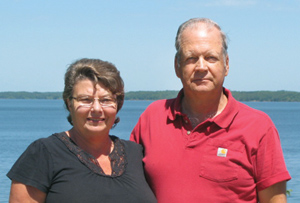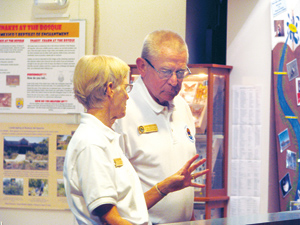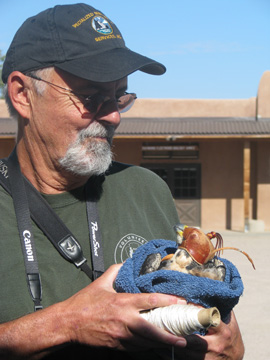Farmers Needed As Volunteers
Farmers Needed As Volunteers
 Early one morning in March 2008, Mike and Joanie McMains received a call from a volunteer coordinator at Bosque del Apache National Wildlife Refuge (NWR) in San Antonio, New Mexico. “We need farmers,” Mary Lou Jorn said over the phone.
Early one morning in March 2008, Mike and Joanie McMains received a call from a volunteer coordinator at Bosque del Apache National Wildlife Refuge (NWR) in San Antonio, New Mexico. “We need farmers,” Mary Lou Jorn said over the phone.
Although Mike had retired from the United States Postal Service as a rural mail carrier, and Jeanie retired in 2007 as office manager of an orthopedic surgery clinic, they had essentially been Iowa farmers for thirty-two years. “We know farming,” Joanie says, noting they had listed their expertise on their Awesome Applicant Resume at Workamper News.
“We had visited a few NWRs, but had never heard of Bosque del Apache,” she continues. “Mary Lou emailed us a website (www.friendsofthebosque.org) to view information and pictures from the refuge. We checked out the site and decided ‘Why not?’ Daniel Perry, volunteer coordinator for Bosque del Apache, sent us a volunteer application to fill out and we were hired.”
In 1997, the McMains had rented their farm land and moved to another acreage. They had enjoyed camping vacations and weekends with family and friends for most of their married life. Anticipating retirement, they began asking questions of acquaintances who were full-time RVers.
Eventually, they sold their farm, and in the spring of 2008, the acreage on which they were living. They auctioned off most of their possessions, holding back a few treasures. The day after the auction, they headed for their first Workamping job for the U.S. Corps of Engineers at Lake Red Rock, Iowa's largest lake located only ten minutes from Pella. They served as custodians of the Fifield Picnic Area for the summer months.
On October 23, 2008, the McMains arrived at Bosque del Apache NWR, supposedly for an assignment ending in February 2009. The positions, Mike as designated field crew, and Joanie for the visitor services rotations, required thirty-two hours per week, working four days on and three days off. Spouses worked the same shifts.
Upon arrival, Mike and Joanie participated in two weeks of general training, including CPR and first aid. Joanie completed on-the-job training with an experienced person in the visitor center. Despite Mike’s experience as a farmer, he took tests and computer training for the tractor crew. After completion, equipment supervisors took him out on the tractors to go over safety and operating procedures.
Mike’s duties included bumping and mowing corn to feed the birds and aerating and breaking up compaction in the field (a job they call “ripping) in preparation for spring planting. He helped lay a five-mile water line to hook the refuge with San Antonio’s water supply.
Joanie’s duties integrated several tasks: tending the gift shop register, staffing the information desk, answering phones, entering data into the computer, roving maintenance, and managing the fee booth at the entrance of the 12-mile wildlife drive. The McManus’ benefits included a full-hook-up site, propane, free laundry, wi-fi, a discount in the gift shop, a small stipend ($10 for every eight hours worked), and a volunteer lounge with TV, computer, books, games, and full kitchen facilities. The volunteer campground is located on the visitor center compound and has 18 sites in the main campground, plus another four for overflow. Joanie says that several volunteers return to “The Bosque,” as they affectionately call the refuge, at various times throughout the year.
The McManus’ benefits included a full-hook-up site, propane, free laundry, wi-fi, a discount in the gift shop, a small stipend ($10 for every eight hours worked), and a volunteer lounge with TV, computer, books, games, and full kitchen facilities. The volunteer campground is located on the visitor center compound and has 18 sites in the main campground, plus another four for overflow. Joanie says that several volunteers return to “The Bosque,” as they affectionately call the refuge, at various times throughout the year.
Although the living arrangements are excellent, the McMains consider a great staff as their most outstanding benefit. “We meet people from all over the country and world. We can help with various research projects, such as rattlesnake research,” Joanie says. “We can assist graduate students with numerous projects involving ducks and banding birds. Pot luck meals happen for any reason, and the weather is ideal.”
Mike comments about the access to hiking and biking trails and the birding opportunities around San Antonio, New Mexico. “The area is rich with local artists, historical places, and unending scenic drives,” he says. “Seeing the sunset ‘Fly In’ and the dawn ‘Fly Out’ is awesome. Sometimes, we see ‘puffs’ of snow geese—thousands rising into the air, often within ten to twenty feet of us. We hear whirring wings and honking, as well as the sounds of other wintering fowl. Birds, mule deer, and families of coyotes are our neighbors. ‘The Bosque’ is a beautiful place.”
Nearing the end of February, 2009—and the close of the McMains’ commitment—the staff discussed their shortage of farmers. Mike offered to stay longer to help with their fieldwork. He mentioned, “Joanie is perfectly capable of driving tractors.” The staff accepted his offer, and trained Joanie on the tractors. At that point, she became one of the field crew. They stayed through March, Joanie ripping up the soil, and Mike root plowing with the bulldozer.
Joanie recalls the fun-loving atmosphere among workers at “The Bosque,” often resulting in practical jokes. One day after her new assignment, she ripped the second alfalfa field on her list. Two staff members drove up, motioning for her to stop the tractor. One of them leaped from the truck, waving maps of the farm fields. He proceeded to tell Joanie, she was in the wrong field. “I had already ripped a large portion,” she says. “I grabbed my map, jumped down from the tractor, and showed them the field they had told me to mark. They started laughing before they said I was in the right field! I think they have a huge practical joke heading their way!” Mike and Joanie returned to the refuge on May 1, 2009, planning to stay for two months to help with more fieldwork. A family emergency called them back to Iowa. However, they returned on July 29 and stayed for the winter of 2009-2010. Mike drove the bulldozer, root plowing wetland managed fields, while Joanie started disking some of the corn fields that failed to make a crop for the wintering birds. She drilled in short maturing grains in hopes of generating extra feed for the thousands of birds that make “The Bosque” their winter home. Next, Joanie started disking and finishing the wetland managed fields, following Mike’s root plowing.
Mike and Joanie returned to the refuge on May 1, 2009, planning to stay for two months to help with more fieldwork. A family emergency called them back to Iowa. However, they returned on July 29 and stayed for the winter of 2009-2010. Mike drove the bulldozer, root plowing wetland managed fields, while Joanie started disking some of the corn fields that failed to make a crop for the wintering birds. She drilled in short maturing grains in hopes of generating extra feed for the thousands of birds that make “The Bosque” their winter home. Next, Joanie started disking and finishing the wetland managed fields, following Mike’s root plowing.
Later, Mike was assigned to bulldozing out invasive species such as Russian olive trees. and Joanie started mowing the wetland managed fields that were not in the rotation for tilling. In October, Joanie ripped more of the alfalfa fields to turn up the roots for the sandhill cranes to eat. These fields were planted in the spring with crops to feed the birds in the winter of 2010-2011. The McMains will return in October 2010 for another volunteer stint.
Mike and Joanie love the RVing lifestyle. “We take our home wherever we go, and Workamping gives us the opportunity to meet wonderful new friends. Hopefully, we make a difference by volunteering,” Mike says. “Besides, it gives us a good reason to get up and get going in the mornings.”
Falcon release.jpg Bosque del Apache in Spanish means "woods of the Apache." The name traces back to the time when the Spanish observed Apaches camped in the riverside forest. Pueblo Peoples lived in the area for centuries before Spanish explorers established The Camino Real (the Royal Road from Mexico City to Santa Fe) in the sixteenth century. The ancient road ran through the present-day refuge. Today, the name of the refuge is synonymous with one of the most spectacular National Wildlife Refuges in North America. Tens of thousands of birds—including sandhill cranes, Arctic geese, and many species of ducks—migrate to the refuge each autumn and stay through the winter.
Over 160,000 visitors annually descend on “The Bosque,” primarily during winter months. The “Festival of the Cranes,” an annual six-day event celebrating the arrival of the sandhill cranes, happens the week prior to Thanksgiving.

